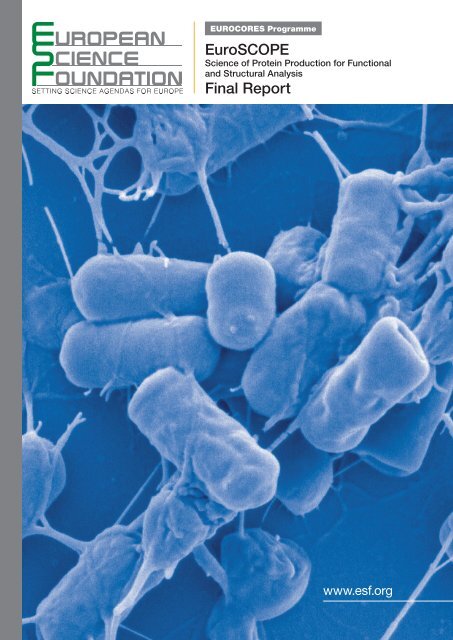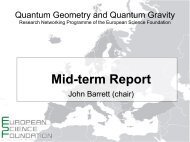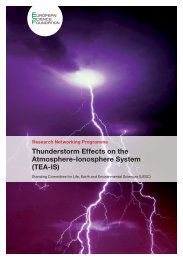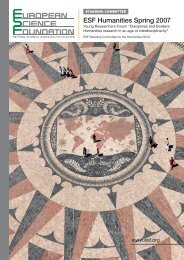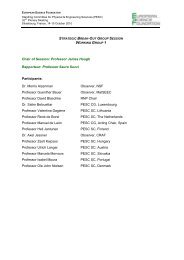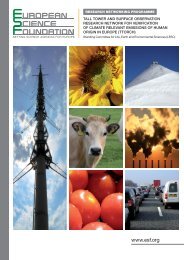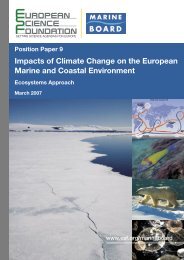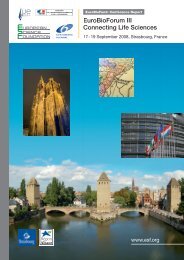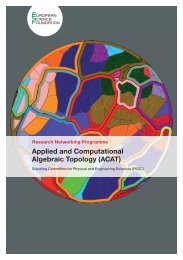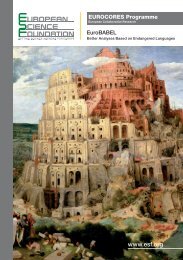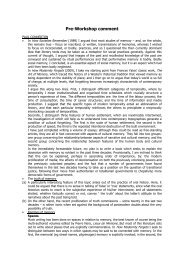EuroSCOPE Final Report - European Science Foundation
EuroSCOPE Final Report - European Science Foundation
EuroSCOPE Final Report - European Science Foundation
You also want an ePaper? Increase the reach of your titles
YUMPU automatically turns print PDFs into web optimized ePapers that Google loves.
1. Description of the <strong>EuroSCOPE</strong> ProgrammeThe <strong>EuroSCOPE</strong> mid-term review was performed bythe Review Panel by written procedure. The final reviewwas based on written reports and a presentation by theProject Leaders during a final Review Panel meeting. Theoverall comments from the Panel were rather positive.“Networking, training and dissemination were performedat a satisfactory level. Personnel exchange and trainingwas good within the different CRPs. The make-up of thedifferent CRPs did not lend itself to significant exchangesof personnel between CRPs”. Regarding the scientificachievements it was mentioned: “All CRPs have deliveredappropriately” and “The BACELL project showed thatthe EUROCORES approach enables standardisation ofexperimental platforms (e.g., SURE system)”.1.3.5 EUROCORES acknowledgementsTo promote the EUROCORES Programme and the nationalfunding organisations which support it (and priorto 2008, the <strong>European</strong> Commission), all publications,posters, websites and other dissemination outputs arerequired to be clearly identified as being Programmefundedor co-funded. This is an important indicator formonitoring the output of the Programmes, particularlypeer-reviewed publications.6 | <strong>EuroSCOPE</strong> – <strong>Science</strong> of Protein Production for Functional and Structural Analysis
2. Highlights of the <strong>EuroSCOPE</strong> Collaborative ResearchProjects2.1 Development and exploitationof Bacillus subtilis as a host for theproduction of protein complexes andmembrane proteins (BACELL)Principal Investigators and Associated Partners(APs)Professor Jan Maarten van Dijl (Project Leader)Laboratory of Molecular Bacteriology, Departmentof Medical Microbiology, University Medical CenterGroningen (UMCG), Groningen, The NetherlandsDr Imrich BarákDepartment of Microbial Genetics, Institute ofMolecular Biology, Slovak Academy of <strong>Science</strong>s,Bratislava, Slovak RepublicProfessor Arnold J.M. DriessenDepartment of Molecular Microbiology, GroningenBiomolecular <strong>Science</strong>s and Biotechnology Instituteand Materials <strong>Science</strong> Center Plus, University ofGroningen, Haren, The NetherlandsProfessor Michael Hecker (AP)Institute of Microbiology, Department of MicrobialPhysiology, Ernst-Moritz-Arndt-University, Greifswald,GermanyDr Vesa P. KontinenAntimicrobial Resistance Unit, Department ofInfectious Disease Surveillance and Control, NationalInstitute for Health and Welfare, Helsinki, Finland(Former affiliation: National Public Health Institute,Helsinki, Finland)Funding OrganisationsFinland: The Academy of Finland (AKA)The Netherlands: The Netherlands Organisationfor Scientific Research (NWO)Slovak Republic: Slovak Research and DevelopmentAgency (SRDA)This project was aimed at the development and exploitationof Bacillus subtilis as a host for the production ofprotein complexes and membrane proteins.The van Dijl team designed and constructed a seriesof engineered B. subtilis strains that allow the high-levelproduction of at least six essential membrane proteinsfrom B. subtilis and Staphylococcus aureus using theSURE expression system. The research has shown thatdispensable membrane-associated stress responsivesystems set major limits to membrane protein overproduction.These bottlenecks were successfully removedfor the overproduction of several membrane proteins.The Kontinen team showed that the PrsA protein, amembrane-bound peptidyl-prolyl cis-trans isomerase,determined stability and cellular levels of a set of essentialpenicillin-binding proteins (PBPs) that are required forlateral cell wall biogenesis in B. subtilis. This explainedwhy PrsA is an essential protein in B. subtilis. PrsA is notdistributed evenly in the membrane, but it is localised indistinct spots that are lined up in spirals along the membrane,a localisation pattern very similar to that of somepenicillin-binding proteins. The results can be exploitedto improve PrsA technology in protein production. TheyFigure 1. Protein quality control and proteolysis in Bacillus subtilis.A) Model for cytoplasmic protein quality control in B. subtilis to whichcytoplasmic proteins, membrane proteins and secretory proteinsare subject. Depending on the presence or absence of targetingsignals, newly synthesised proteins can be targeted for secretion ormembrane insertion, or they can remain in the cytoplasm. If controlof their folding by chaperones is insufficient these proteins canmisfold and/or aggregate. This can lead to degradation by proteasessuch as ClpCP, ClpEP or ClpXP. Alternatively, misfolded proteins canbe refolded with the help of chaperones. B) Model for protein qualitycontrol and degradation of membrane proteins within the membraneof B. subtilis. Proteins targeted to the membrane can be subject toprocessing by signal peptidases (e.g., SipS-W) or to degradationby membrane-associated proteases such as FtsH, PrsW, RasP orSpoIVFA. C) Model for extracytoplasmic protein quality control anddegradation in B. subtilis. Translocated secretory proteins can foldwith the help of folding catalysts such as PrsA. Accumulation ofmisfolded translocated proteins at the membrane-cell wall interfacecan trigger a secretion stress response, involving the CssRS twocomponentregulatory system. If activated, CssRS causes theup regulation of membrane-associated proteases such as HtrAand HtrB. These two proteins can probably catalyse both proteindegradation and protein folding. Misfolded proteins are furthermoresubject to degradation by cell wall-associated and/or secretedproteases, such as AprE, Bpf, Epr, Mpr, NprB, NprE, Vpr and/orWprA. (Adopted from Zweers et al. 2009, Microbial Cell Factories 7,10, published by BioMed Central)<strong>EuroSCOPE</strong> – <strong>Science</strong> of Protein Production for Functional and Structural Analysis | 7
2. Highlights of the <strong>EuroSCOPE</strong> Collaborative ResearchProjectsalso open possibilities to search for new cell wall-activeantimicrobial agents, PrsA inhibitors.In the Driessen group multi-spanning membrane proteins(SpoIIIJ and YqjG) were overexpressed to highlevels in B. subtilis using the SURE system. Furthermorea high molecular mass complex (500 kDa) consistingof SpoIIIJ/YqjG and the entire F1FO- ATP synthasewas isolated from membrane fractions. Blue-native gelelectrophoresis was successfully used for monitoringthe complex. A number of B. subtilis knockout strainswere created, e.g., SpoIIIJ and YqjG double knockoutswith either xylose-inducible SpoIIIJ or YqjG. These wereanalysed in a membrane proteomic approach to identifymembrane proteins that depend specifically on these twomembrane protein integrases. By combined in vitro andin vivo assays it was shown that both SpoIIIJ and YqjGplay an important role in membrane protein insertion.In the Barák team efficiency and usefulness of differentB. subtilis expression systems were compared to studythe assembly of B. subtilis protein complexes and membraneproteins involved in asymmetric cell division andprogrammed cell death. A high-level production strainfor the cell division protein DivIVA was constructed thatallows its isolation and purification in sufficient amountsfor further biochemical, electron microscopical andstructural analyses. An efficient screening system wasdeveloped for identifying mutations that either enhancethe production of the sporulation-specific membraneprotein SpoIIE, or influence folding, membrane insertionor disulphide bond formation, thereby leading toefficient sporulation.The Hecker team developed protocols for qualitativeand quantitative membrane proteome analyses. Thesehave been effectively implemented in the research of theteam to investigate the effects of mutations that enhancemembrane protein biogenesis, or to characterise theroles of certain components involved in this process.Publications directly related to the project(* Key publications)Barák, I. and Wilkinson, A.J. (2007) Division site recognitionin Escherichia coli and Bacillus subtilis. FEMS Microbiol.Reviews Apr. 31(3), 311-326.*Barák, I., Muchová, K., Wilkinson, A.J., OToole, P.J. andPavlendová, N. (2008) Lipid spirals in Bacillus subtilis andtheir role in cell division. Mol. Microbiol. 68, 1315-1327.Dubois, J.Y.F., Kouwen, T.R.H.M., Schurich, A.K.C., Reis,C.R., Ensing, H.T., Trip, E.N., Zweers, J.C. and van Dijl,J.M. (2009) Immunity to the bacteriocin sublancin 168 isdetermined by the SunI (YolF) protein of Bacillus subtilis.Antimicrob. Agents Chemother. 53, 651-661.Florek, P., Muchová, K., Pavelčíková, P. and Barák, I. (2008)Expression of functional Bacillus SpoIISAB toxin-antitoxinmodules in Escherichia coli. FEMS Microbiol. Letters 278,177-184.Hyyryläinen, H.L., Pietiäinen, M., Lunden, T., Ekman, A.,Gardemeister, M., Antelmann, H., Hecker, M., Valmu,L., Sarvas, M. and Kontinen, V.P. (2007) The density ofnegative charge in the cell wall influences two-componentsignal transduction in Bacillus subtilis. Microbiology 153,2126-2136.*Kouwen, R.H.M., Dubois, J.Y.F., Freudl, R., Quax, W.J.and van Dijl, J.M. (2008) Modulation of thiol-disulfideoxidoreductases for increased production of disulfidebond-containing proteins in Bacillus. Appl. Environ.Microbiol. 74, 7536-7545.Kouwen, T.R.H.M. and van Dijl, J.M. (2009) Interchangeablemodules in bacterial thiol-disulfide exchange pathways.Trends Microbiol. 17, 6-12.*Kouwen, T.R.H.M., van der Ploeg, R., Antelmann, H., Hecker,M., Homuth, G., Mäder, U. and van Dijl, J.M. (2009)Overflow of a hyper-produced secretory protein from theBacillus Sec pathway into the Tat pathway for proteinsecretion as revealed by proteogenomics. Proteomics 9,1018-1032.Kouwen, T.R.H.M., Antelmann, H., van der Ploeg, R.,Denham, E.L., Hecker, M. and van Dijl, J.M. (2009)MscL of Bacillus subtilis prevents selective releaseof cytoplasmic proteins in a hypotonic environment.Proteomics 9, 1033-1043.Kouwen, T.R.H.M. and van Dijl, J.M. (2009) Applicationsof thiol-disulfide oxidoreductases for optimized in vivoproduction of functionally active proteins in Bacillus. Appl.Microbiol. Biotechnol. 53, 4702-4711.Kouwen, T.R.H.M., Trip, E.N., Denham, E.L., Sibbald,M.J.J.B., Dubois, J.Y.F. and van Dijl, J.M. (2009) The largemechanosensitive channel MscL determines bacterialsusceptibility to the bacteriocin sublancin 168. Antimicrob.Agents Chemother. 53, 4702-4711.Kouwen, T.R.H.M., Nielsen, A.K., Denham, E.L., Dubois,J.-Y.F., Dorenbos, R., Rasmussen, M.D., Quax, W.J.,Freudl, R. and van Dijl, J.M. (2009) Contributions of thepre- and pro-regions of a Staphylococcus hyicus lipaseto secretion of a heterologous protein by Bacillus subtilis.Appl. Environ. Microbiol. Nov 30. [Epub ahead of print]Pavlendová, N., Muchová, K. and Barák, I. (2007)Chromosome segregation in Bacillus subtilis. FoliaMicrobiologica 52, 563-572.Pavlendová, N., Muchová, K. and Barák, I. (2009)Expression of Escherichia coli Min system in Bacillussubtilis and its effect on cell division. FEMS Microbiol.Letters, Oct. 23. [Epub ahead of print]*Saller, M.J., Fusetti, F. and Driessen, A.J.M. (2009) Bacillussubtilis SpoIIIJ and YqjG function in membrane proteininsertion. J. Bacteriol. 191, 6749-6757.Tang, J., Krajcikova, D., Zhu, R., Ebner, A., Cutting, S.,Gruber, H.J., Barák, I. and Hinterdorfer, P. (2007) Atomicforce microscopy imaging and molecular recognitionforce spectroscopy of coat proteins on the surface ofBacillus subtilis spore. J. Mol. Recognition 20(6), 83-489.*Westers, L., Westers, H., Zanen, G., Antelmann, H., Hecker,M., Noone, D., Devine, K.M., van Dijl, J.M. and Quax, J.M.(2008) Genetic or chemical protease inhibition causessignificant changes in the Bacillus subtilis exoproteome.Proteomics 8, 2704-2713.Yuan, J., Zweers, J.C., van Dijl, J.M. and Dalbey, R.E.(2009) Protein transport across and into cell membranesin bacteria and archaea. Cellular and Molecular Life<strong>Science</strong>s, Oct. 10. [Epub ahead of print]8 | <strong>EuroSCOPE</strong> – <strong>Science</strong> of Protein Production for Functional and Structural Analysis
*Zweers, J.C., Barák, I., Becher, D., Driessen, A.J.M.,Hecker, M., Kontinen, V.P., Saller, M.J., Vavrová, L. andvan Dijl, J.M. (2008) Development of Bacillus subtilis as acell factory for membrane proteins and protein complexes.Microb. Cell Fact. 7, 10.*Zweers, J.C., Wiegert, T. and van Dijl, J.M. (2009)Stress responsive systems set specific limits to theoverproduction of membrane proteins in Bacillus subtilis.Appl. Environ. Microbiol. 75, 7356-7364.2.2 Folding, production and assemblyof viral complexes for high resolutionstructure analysis (FOLPROCOM)Principal Investigators andAssociated Partners (APs)Dr Roman Tuma (Project Leader)The Astbury Centre for Structural Molecular Biology,Institute of Molecular and Cellular Biology, Facultyof Biological <strong>Science</strong>s, University of Leeds, Leeds,United Kingdom(Former affiliation: Institute of Biotechnology,University of Helsinki, Helsinki, Finland)Professor Ineke BraakmanDepartment of Cellular Protein Chemistry,Faculty of Chemistry, Utrecht University, Utrecht,The NetherlandsDr Sarah Jane ButcherInstitute of Biotechnology, University of Helsinki,Helsinki, FinlandDr Iva PichovaDepartment of Protein Biochemistry, Institute ofOrganic Chemistry and Biochemistry, Academyof <strong>Science</strong>s of the Czech Republic, Prague,Czech RepublicDr Mark J. van RaaijConsejo Superior de Investigaciones Cientificas(CSIC), Department of Structural Biology, Institute ofMolecular Biology of Barcelona, Barcelona, SpainProfessor Saskia M. van der ViesDepartment of Biochemistry and Molecular Biology,Faculty of <strong>Science</strong>, VU University Amsterdam,Amsterdam, The NetherlandsFunding OrganisationsCzech Republic: The Czech <strong>Science</strong> <strong>Foundation</strong>(GAČR)Finland: The Academy of Finland (AKA)The Netherlands: The Netherlands Organisation forScientific Research (NWO)Spain: Ministry of <strong>Science</strong> and Innovation (MICINN)This project endeavoured to fi rst develop protein expression,folding and assembly systems that were thenused to produce viral complexes and to perform highresolution structural analyses of viral intermediary complexes.The teams of Butcher and Tuma focused on viral proteinexpression, assembly and structure determination ofviruses. They managed to produce viruses from severalextremophillic organisms and the structures of theseprovided novel insights into early evolution of viruses.The expression, functional and structural characterisationof proteins and assemblies from dsRNA viruses yieldedpotential drug targets. The viruses under study includedan avian reovirus, which is a major life stock pathogen.The Van Raaij and Benavente teams produced viralfibres (sigmaC 117-326) and determined the structure ofthose and targeted assembly of dsRNA avian reovirus(published in the Journal of General Virology, March2009).Figure 2. Structure of sigmaC 117-326. Crystals of sigmaC 117-326were obtained, diffract to 1.9 Å resolution- circular DABC-HEFGsheet, long DE-loop, 2 triple beta-spiral repeats- 2 Cl- (coordinatedby 3 Asn each) and Zn2+ ion (coordinated by 3 His).Courtesy of Dr Mark van Raaij / Professor Javier BenaventeThe team of Pichova and Ruml worked on the structuralbasis of retroviral targeting to the assembly site andmechanism of protease activation. Knowledge aboutthese processes may lead to the development of noveldrugs.M-PMV (B/D type)HIV (C type)Figure 3. Intracellular assembly of M-PMV-capsids. M-PMVassembles immature particles in the cytoplasm and activation ofthe protease within the immature particles is delayed until viralbudding. Courtesy of Dr Iva Pichova<strong>EuroSCOPE</strong> – <strong>Science</strong> of Protein Production for Functional and Structural Analysis | 9
3. Networking and Dissemination ActivitiesThe <strong>EuroSCOPE</strong> Satellite Workshop at the 13 th<strong>European</strong> Congress on Biotechnology was the mostvisible and thus most influential dissemination activity. Allthree CRPs presented their progress and the ESF gavean overview on <strong>EuroSCOPE</strong> and EUROCORES in general.Two international experts were invited for keynotelectures on complex protein production and structural biology.The chair of the workshop was Antonio Villaverde,one of the Principal Investigators of GENOPHYS.5 th EFB (<strong>European</strong> Federationof Biotechnology) Meeting onRecombinant Protein Productionnear Alghero (Sardinia, Italy), 24-28 September 2008The 5 th EFB Meeting on Recombinant Protein Productionfocused on how physiology impacts upon recombinantprotein production in all types of cell: bacteria, mammaliancell culture, yeasts and filamentous fungi, plantand insect cell lines as well as from viral vectors.A <strong>EuroSCOPE</strong> Satellite Meeting was held at the 5 thRecombinant Protein Production Conference. TheEUROCORES Programme was briefly introduced, andall CRPs gave presentations on the scientific progress oftheir projects. External scientists were invited to presenttheir recent work on topics related to <strong>EuroSCOPE</strong>.Members of GENOPHYS were members of the ScientificCommittee and chairs of several scientific sessions.14 | <strong>EuroSCOPE</strong> – <strong>Science</strong> of Protein Production for Functional and Structural Analysis
4. Networking and Dissemination ActivitiesThe first achievements in synthetic biology includethe design and implementation of synthetic geneticcircuits, the design of novel biochemical pathways forthe production of valuable pharmaceuticals, and thede novo synthesis of bacterial genomes. The ultimateambition of the field is to extend the mastery of biologicalengineering to systems complex enough to deal withgrand challenges such as the design, synthesis anddelivery of novel therapeutic treatments, affordable andprecise diagnosis of diseases, novel routes to vaccines,production of liquid transportation fuels, bioremediationof pollutants, biocompatible carbon sequestration,and efficient manufacturing of biopharmaceuticals andbiochemicals.The projects that are considered for funding will startin early 2010.More information can be found at:www.esf.org/eurosynbio4.3 Research Networking Programme:The Euroglycoscience Forum(EUROGLYCOFORUM)Glycoscience is a term used to describe all the areaswhich relate to complex carbohydrates, their synthesisand biosynthesis, analysis, function and applications.Glycoscience is a rapidly expanding and exciting fieldthat is relevant to many areas of chemistry, biology andmedicine. A significant number of <strong>European</strong> laboratoriesare considered to be at the forefront of current glycoscienceresearch, and the current programme aims tostrengthen that position. Whilst important discoverieshave been made in the individual disciplines of glycoscience,it is generally recognised that future successeswill rely on large interdisciplinary consortia which havesufficient tools and resources to address the complexquestions that lie ahead.From our current studies it is apparent that a trueunderstanding of the role of glycosylation in complex biologicalsystems will rely on close collaboration betweenbiophysical scientists skilled in glycoscience technologiesand scientists working in cell biology and medicine. Thenuclei of such consortia have already formed in <strong>European</strong>d the current proposal is to foster such efforts andprovide an umbrella organisation, the EuroglycosciencesForum, that will establish a cohesive research landscapefor glycoscientists on which to build future successes.The Euroglycosciences Forum will aim to provide convenientand active links between the leading researchgroups in the field through a series of meetings andworkshops. It will also promote the establishment ofkey resources for glycoscientists, such as bioinformaticstools, microarray technologies, chemical synthesisof glycans, novel methods in structural analysis of carbohydrates,enzymology of proteins involved in glycanbiosynthesis and metabolism, and molecular and cellbiology of carbohydrate-binding proteins. Availability ofthese resources will ultimately lead to wider applicationssuch as carbohydrate-based therapeutics, diagnosticsand materials both in academia and industry.There are quarterly calls for proposals, the 2 ndEUROGLYCOFORUM Call for Proposals having the nextdeadline of 1 March 2010.For more information, please seewww.esf.org/glycoscience4.4 Other activities: Bacell consortiumBacell is the umbrella organisation supporting Bacillusresearch in Europe. The Bacillus bacterium has beenused for more than 50 years as a model to understandthe detailed functions of individual cellular components.As a result, it is one of the best understood of all livingorganisms. Each component has a specific role and locationwithin the cell. The next challenge is to determinethe precise location of the individual components andto model how they interact with each other and theirsurroundings to form a successful living organism. Inaddition to its importance to basic science, Bacilluscontributes to the health and wealth of society and theenvironment.Through Bacell, the BACELL <strong>EuroSCOPE</strong> partners areconnected to other <strong>European</strong> research programmes fundedby the <strong>European</strong> Commission, such as Tat machine,StaphDynamics, BaSysBio, Bacell SysMo and TranSys.For more information, please seewww.bacell.euFigure 6. Scope of the Bacell activities.Source: http://www.bacell.eu/16 | <strong>EuroSCOPE</strong> – <strong>Science</strong> of Protein Production for Functional and Structural Analysis
4.6 Upcoming Research Conferences• ESF Research ConferenceBacterial Networks 2010Sant Feliu de Guixols, Spain, 4-9 September 2010• ESF-EMBO SymposiumMolecular Perspectives on Protein-ProteinInteractionsSant Feliu de Guixols, Spain, 21-26 November 2010Figure 7. Logo of the ConferenceInformation will be made available in due course onhttp://www.esf.org/activities/esf-conferences/4.5 Research Conference:ESF-UB Conference in Biomedicine<strong>European</strong> Conference on Synthetic Biology (ECSB) IISant Feliu de Guixols, Spain, 29 March – 3 April 2009Two communities are emerging within synthetic biology,namely top-down – i.e., knocking out or modifying functionsof existing cells, and bottom-up – i.e., constructionof artificial systems from first principles, protocells, etc.The aim of this conference was to generate new vigorousinteractions between the disciplines that impingeon (and contribute to) Synthetic Biology, and to bringtogether in the same context top-down and bottomupresearchers. Some of the topics presented at theconference were: DNA sequencing and synthesis, chemicaland biological networks, computational techniques(modelling, data mining, optimisation) for synthetic biology,minimal genomes, evolution (natural, directed andsimulated), origins of life, biological systems, cell cyclesand circuits, and infrastructures for synthetic biology,minimal cells.For more information, please seehttp://www.esf.org/activities/esf-conferences.html<strong>EuroSCOPE</strong> – <strong>Science</strong> of Protein Production for Functional and Structural Analysis | 17
5. ConclusionsThe Review Panel (RP) conducted a written assessmentof the <strong>EuroSCOPE</strong> Programme in general and specificallythe submitted final reports of the CRPs. At the finalmeeting with the RP, the Project Leaders also presentedthe outcome of their CRPs and looked forward to futureinitiatives. The presentations were followed by a discussionwith the panel.With regards to the organisational aspects of theProgramme, the RP specifically commented that thesubcritical mass of participating <strong>European</strong> countries thatwere supporting the programme was a major drawback.The original Programme was designed to cover a broadrange of topics having various subfields and multiplecalls for proposals. In practice, the Programme had to bereduced in its scope and ambition in order to comply withthe limited amount of funding that was committed.Initially, the Programme suffered from a rather long reviewingprocedure (2004-2006) followed by a time delaybefore the start of funding for the CRPs. This was consideredas a start-up problem for the newly developedEUROCORES Programme Scheme, and current improvementsof the Scheme should ensure that such delays atthe preparatory stage can be avoided in future.The RP members also indicated that they would havepreferred to be more closely involved in the networkingand dissemination activities of the Programme.In terms of scientific achievements the <strong>EuroSCOPE</strong>Programme delivered a series of valuable outputs. Asa main highlight the RP mentioned the optimisation ofB. subtilis production system for efficient expression ofcomplex membrane proteins. The Programme has alloweda number of <strong>European</strong> scientists to maintain andextend their leadership in the field of B. subtilis research.Moreover, the consortium demonstrated its ability tocreate synergism by bringing together complementaryfunding schemes from across Europe.The proof of principle for the use of the Picchia pastorissystem for improved production of complex proteinshas been delivered. As an important spin-off from theprogramme, the RP mentioned the possibility of “knowledgetransfer” to industrial partners in relation to thehypoxic batchfed system.A novel chaperone required for specific protein complexassembly was identified, underlining the need forthe identification and potential exploitation of specialisedcellular components in some cases.For the whole Programme transnational scientific collaborationwas demonstrated by a respectable list ofhigh-quality co-authored research publications.Networking, training and dissemination was performedat a satisfactory level. Personnel exchange and trainingwas good within the different CRPs. The set-up andobjectives of the different CRPs did not lend itself tosignificant exchanges of personnel between CRPs. Itwas recommended that in future there should be moreinter-CRP exchange to enable participants to access newtechnologies and approaches that might be beneficialfor their work.18 | <strong>EuroSCOPE</strong> – <strong>Science</strong> of Protein Production for Functional and Structural Analysis
6. Governing Bodies6.1 Management CommitteeDr Olga DiasPortuguese <strong>Science</strong> and Technology <strong>Foundation</strong>(FCT), PortugalDr Jan DijkhofThe Netherlands Organisation for Scientific Research(NWO), The NetherlandsDr Sonia FtácnikovaSlovak Research and Development Agency,Slovak RepublicDr Benno HinnekintResearch <strong>Foundation</strong> – Flanders (FWO), BelgiumMs Elisabeth KokkelkorenNational Fund for Scientific Research (FNRS),BelgiumDr Veronika PaleckovaThe Czech <strong>Science</strong> <strong>Foundation</strong>, Czech Republic(GAČR)Dr Branislav PeťkoSlovak Academy of <strong>Science</strong>s, Slovak RepublicDr Jukka ReivinenThe Academy of Finland, FinlandDr Rosa Rodriguez-BernabéMinistry of Education and <strong>Science</strong> (MEC), SpainMr Tom SheedyEnterprise Ireland, IrelandDr Meelis SirendiEstonian <strong>Science</strong> <strong>Foundation</strong>, EstoniaDr Graham TebbAustrian <strong>Science</strong> Fund (FWF), Austria6.2 Scientific CommitteeProfessor Jan Maarten van DijlUniversity Medical Center Groningen (UMCG),Groningen, The NetherlandsProfessor Diethard MattanovichUniversity of Natural Resources and Applied Life<strong>Science</strong>s, Vienna, AustriaDr Roman TumaUniversity of Leeds, Leeds, United Kingdom6.3 International Review Panel(members in 2006: *, members in 2009: #)Professor Burkhard Bechinger *#University of Strasbourg/CNRS, Strasbourg, FranceProfessor Stephen High #University of Manchester, Manchester,United KingdomProfessor Jens Nielsen #Chalmers University of Technology, Göteborg,SwedenProfessor John R Riordan *Mayo Clinic, Scottsdale, AZ, USAProfessor Robert Tampé *#Johann Wolfgang Goethe-University,Frankfurt/Main, GermanyDepartment of Biochemistry & Biophysics,University of California San Francisco, UCSF, USAProfessor Matthias Wilmanns *#<strong>European</strong> Molecular Biology Laboratory (EMBL)c/o DESY, Hamburg, Germany<strong>EuroSCOPE</strong> – <strong>Science</strong> of Protein Production for Functional and Structural Analysis | 19
1 quai Lezay-Marnésia | BP 9001567080 Strasbourg cedex | FranceTel: +33 (0)3 88 76 71 00 | Fax: +33 (0)3 88 37 05 32www.esf.orgPrint run: 500 – December 2009


